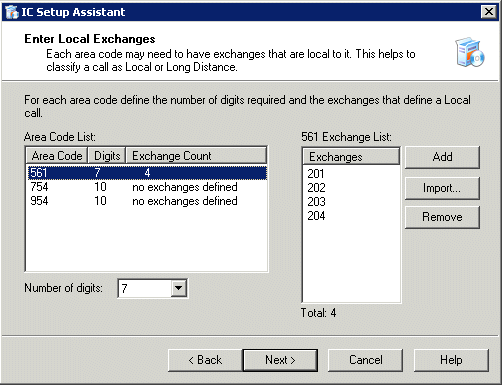- Contents
IC Setup Assistant Help
Enter Local Exchanges
This dialog appears if you selected to have IC Setup Assistant create a dial plan in the Select the Dial Plan dialog.
For each area code you defined in the Enter the Local Area Codes dialog, specify the number of digits required (7, 10, or 11 digit) and the exchanges that define a local call. If all local calls are within one single area code, exchanges are not required.
The CIC Server uses this information to categorize outgoing calls for several purposes, including the displayed caller ID and for reporting purposes. If you don't enter the exchanges, the CIC Server may not be able to generate reports correctly.
Alternatively, you can configure any aspect of your dial plan in Interaction Administrator (Phone Numbers container) after IC Setup Assistant completes.
Area Code List
The changes you make to set the number of digits for each area code, and the exchanges added for each area code are reflected in this list box.
Number of digits
For each area code in the Area Code List, define the number of digits (7, 10, or 11) that are required to make a local call.
Highlight an area code, select either 7, 10, or 11 in the Number of digits list box.
Example: Number of DigitsIn the following example, the CIC Server resides in an area where local calls can be made within the 561, 754, and 954 area codes.
-
For outbound calls in the 561 area code, several exchanges are 7-digit calls. Those exchanges are 201, 202, 203, and 204.
-
For outbound calls in the 754 area code, all calls require 10 digits.
-
For outbound calls in the 954 area code, all calls require 10 digits.

Exchange List
For each area code in the Area Code List, add the exchanges for that area code.
Local exchanges in the North American Numbering Plan (NANP) are three digit numbers in the range of 200 to 999. This information may be available in a local phone book or you can contact your telephone service provider (CO) to request a complete listing of local exchanges, and possibly a list of exchanges within the area code that are long distance charges from your site.
You can add exchanges for an area code in two ways. Highlight an area code, and click one of the following buttons:
-
Click Add to manually add the exchange(s) for this area code. The Enter Numbers dialog appears.
-
Click Import to import a text file with local exchanges for that area code. The exchange values must be separated by commas or spaces. Browse to the location of the Import Exchanges .txt file. By default, IC Setup Assistant looks in the \I3\IC\Manifest directory. If the it is not located in this directory, browse to the appropriate directory.
To remove an area code from the list, highlight the area code and click Remove.
Example: Exchange CodesPhone numbers are represented as:
1aaaeeexxxx
where aaa = area code and eee = exchange code.
In this example, you have three local area codes: 111, 222, and 333. All calls to numbers within these three area codes are considered local calls.
-
All calls to numbers in area code 111 require that you specify the area code (1aaaeeexxxx). You don't need to enter any exchanges for this area code.
-
For calls to phone numbers in the area code 222, some require 7-digit dialing (eeexxxx), and some require 11-digit dialing (1aaaeeexxxx). All calls to numbers in the 555 exchange (i.e. 555-2394) use 7-digit dialing. For this you would enter the exchange 555 in Setup Assistant.
-
For calls to phone numbers in the area code 333, all are 7-digit calls (eeexxxx). For this area code you would enter every exchange.





